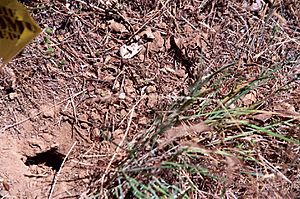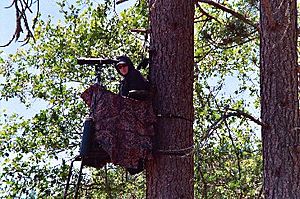Boggs Lake Ecological Reserve facts for kids
Quick facts for kids Boggs Lake Ecological Reserve |
|
|---|---|
|
IUCN Category Ia (Strict Nature Reserve)
|
|

Boggs Lake / vernal pool
|
|
| Location | Lake County, California |
| Nearest city | Clearlake, California |
| Established | 1973 |
| Governing body | The Nature Conservancy |
The Boggs Lake Ecological Reserve is a special nature reserve located in Lake County, California. It's about one quarter of a square mile in size. This area is home to a big vernal pool, which is a seasonal pond that fills with water in winter and spring. It also protects rare plants, like the Boggs Lake hedge-hyssop.
The Nature Conservancy and the California Department of Fish and Game work together to manage Boggs Lake. It is about 8 miles (13 km) south of Clear Lake. There's a small parking area and a hiking trail loop for visitors. The Nature Conservancy put up a protective fence and signs to help people learn about the area.
The lake sits in a natural dip formed by volcanoes. This dip is lined with a very fine layer of volcanic ash. This ash has become very hard and doesn't let water through. When the lake is full, its surface covers about 90 acres (360,000 m2).
Boggs Lake became a protected area in 1973. This happened because the California Native Plant Society (CNPS) wanted to save the land from being built on. Today, it's a protected area that keeps many endangered plants and animals safe.
Contents
Why Boggs Lake is Special
Boggs Lake is important because it has a unique type of habitat called a vernal pool. These pools are like temporary wetlands. They fill up with water during the rainy season and then dry out later in the year. Many special plants and animals can only live in these kinds of places.
Protecting Rare Plants and Animals
The reserve is a safe home for several plants and animals that are hard to find elsewhere. Protecting places like Boggs Lake helps make sure these species don't disappear forever. It's a great example of how people can work together to save nature.
History of Boggs Lake Reserve
Years ago, a company called Fibreboard Corporation owned the land where Boggs Lake is. In the early 1970s, some members of the California Native Plant Society (CNPS) and scientists from the University of California asked the company to protect the vernal pool and the nearby forest. Even though the area was mostly untouched, there were plans for logging and other activities. These activities could have harmed the delicate natural balance.
Fibreboard Corporation agreed to help. They gave the land to the CNPS in 1973. Then, the CNPS asked The Nature Conservancy to help manage the land and handle legal matters. This new protected area was called the Boggs Lake Preserve. It was a bit more than 100 acres (0.40 km2) and included most of the lake. The Nature Conservancy quickly added it to their list of protected places.
Growing the Preserve
A group called the Boggs Lake Preserve Committee was formed. For the next 10 years, they studied and mapped the rare plants in the preserve. Their research showed that the original boundaries of the preserve weren't big enough. Some unique plants were growing outside the protected area. Also, more and more off-road vehicles were driving in the area. There was even a plan for a housing development near the lake. This could have caused algae to grow from septic tank water leaking into the lake. Logging and using geothermal resources were still possible threats too.
In 1984, The Nature Conservancy created a new plan for the preserve. Based on all the studies, they decided to make the protected area bigger. They added two large and six small pieces of land around the lake's edge. They also added a big meadow west of the lake. These new areas were bought with money donated by individuals and foundations. This expansion also helped connect the preserve to a county road, making it easier for the public to visit.
The story of the Boggs Lake Ecological Reserve became a great example. It showed how important it is to study an area carefully before trying to protect it. In the past, The Nature Conservancy sometimes chose places to protect based on what was available. But now, they use scientific information to decide which areas are most important to save.
Plants and Animals of Boggs Lake
The forest around Boggs Lake has many different trees. You can find softwoods like ponderosa pine and Douglas-fir. There are also hardwoods like black, canyon, and live oak trees, as well as madrone trees.
Other plants growing at Boggs Lake include poison oak, manzanita, wild pea, bracken fern, coyote thistle, wild mustard, and California or ground rose.
Many animals live here too. You might see deer, coyotes, jackrabbits, chipmunks, gray squirrels, raccoons, skunks, bobcats, and foxes.
Birds use the vernal pool as a resting spot when they migrate. They also live there all year round. Between 1982 and 1987, people saw 139 different kinds of birds at Boggs Lake! This included both bald and golden eagles. Other birds seen here are the pygmy nuthatch, pileated woodpecker, hermit warbler, purple martin, red-winged blackbird, ruddy duck, marsh wren, mallard, and California quail.
Endangered Plants
The Boggs Lake hedge-hyssop was first found in Lake County in 1923. It grows to be about four inches tall. It has long, narrow leaves and small yellowish-white flowers. These flowers bloom from April to August. You can find it in vernal pools, marshy areas, and at the edges of lakes and cattle ponds. It can even bloom when there's up to two inches of water.
The few-flowered Navarretia is part of the Phlox family. It was first collected near Lower Lake in 1945. This plant is an annual herb, meaning it lives for one year. It has lobed leaves and grows to almost two inches tall. It has small, tube-shaped white or purple flower clusters. Like many vernal pool plants, it starts growing underwater. It blooms in May and June, after the pool has dried up.
Western Pond Turtle
The western pond turtle (Clemmys marmorata or Actinemys marmorata) is one of the reptiles living at Boggs Lake. The California Department of Fish and Game (CDFG) lists it as a species of special concern. This means it needs special protection. Boggs Lake is a great home for these turtles. It has water for them to eat and control their body temperature. It also has dry land nearby where they can lay their eggs. These areas are safe from being underwater. They also have sunny spots where the turtles can warm up.
In June 2008, Sonoma State University (SSU) started a study project at Boggs Lake. They received money from SSU and the Sonoma County Fish and Wildlife Commission. The project aims to help prevent these turtles from becoming extinct. They are also trying to solve a mystery: how temperature affects whether a turtle egg becomes a male or female. Turtle eggs from Boggs Lake are being hatched at different temperatures to find this out. The turtles will eventually be released back into Boggs Lake.
The western pond turtle has been affected by the destruction of its habitat. They used to be common from Washington state all the way down to Baja California. Now, you can only find them in a few isolated areas in Southern California and the Central Valley.
Nick Geist, a biology professor at SSU, said, "Western Pond Turtles are a snapshot of what is happening to turtles in general. Turtles are in decline on a global basis." This means that what is happening to these turtles at Boggs Lake is also happening to turtles all over the world.





